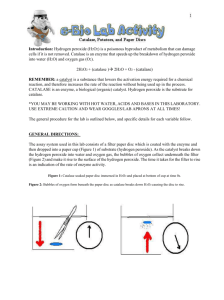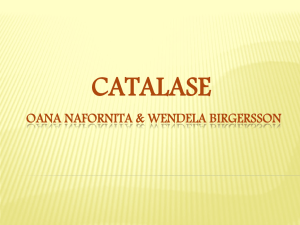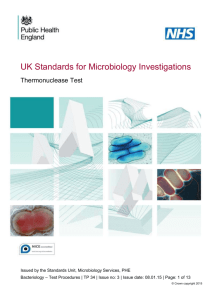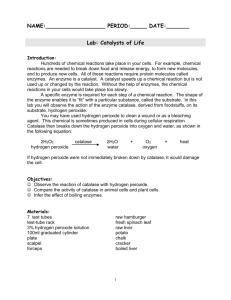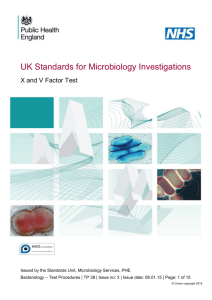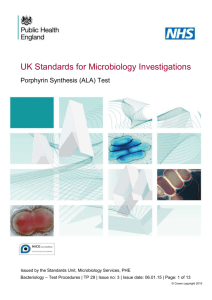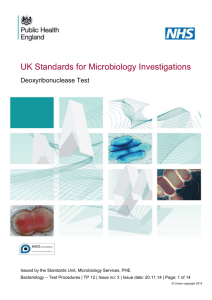TP 8i3 November 2014
advertisement
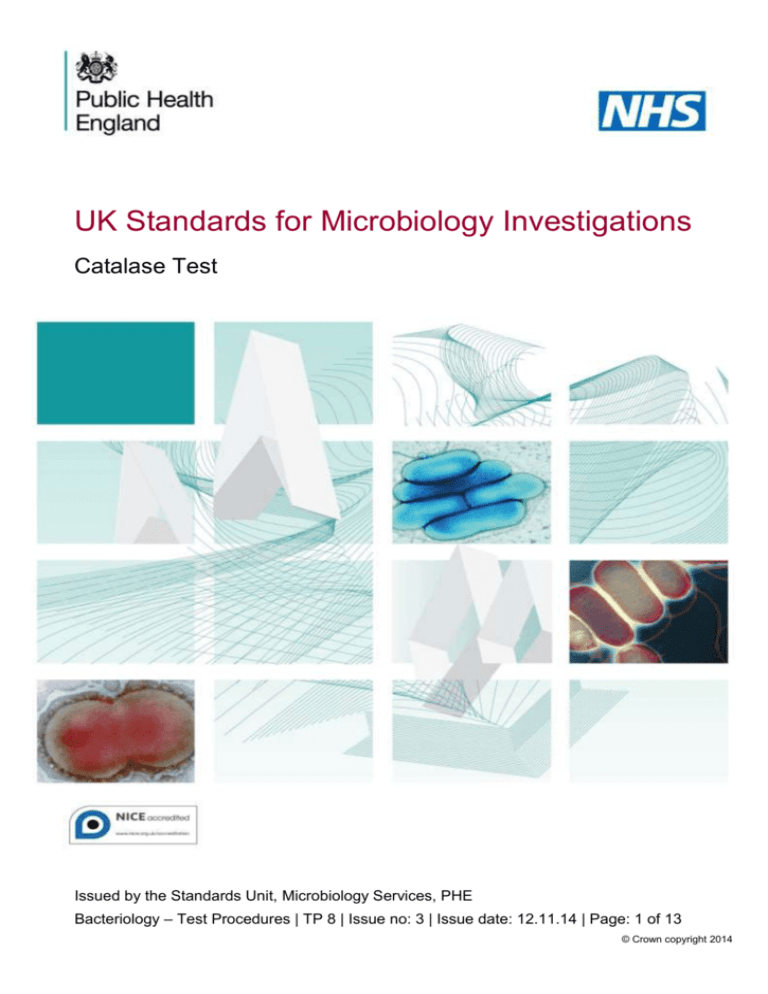
UK Standards for Microbiology Investigations Catalase Test Issued by the Standards Unit, Microbiology Services, PHE Bacteriology – Test Procedures | TP 8 | Issue no: 3 | Issue date: 12.11.14 | Page: 1 of 13 © Crown copyright 2014 Catalase Test Acknowledgments UK Standards for Microbiology Investigations (SMIs) are developed under the auspices of Public Health England (PHE) working in partnership with the National Health Service (NHS), Public Health Wales and with the professional organisations whose logos are displayed below and listed on the website https://www.gov.uk/ukstandards-for-microbiology-investigations-smi-quality-and-consistency-in-clinicallaboratories. SMIs are developed, reviewed and revised by various working groups which are overseen by a steering committee (see https://www.gov.uk/government/groups/standards-for-microbiology-investigationssteering-committee). The contributions of many individuals in clinical, specialist and reference laboratories who have provided information and comments during the development of this document are acknowledged. We are grateful to the Medical Editors for editing the medical content. For further information please contact us at: Standards Unit Microbiology Services Public Health England 61 Colindale Avenue London NW9 5EQ E-mail: standards@phe.gov.uk Website: https://www.gov.uk/uk-standards-for-microbiology-investigations-smi-qualityand-consistency-in-clinical-laboratories UK Standards for Microbiology Investigations are produced in association with: Logos correct at time of publishing. Bacteriology – Test Procedures | TP 8 | Issue no: 3 | Issue date: 12.11.14 | Page: 2 of 13 UK Standards for Microbiology Investigations | Issued by the Standards Unit, Public Health England Catalase Test Contents ACKNOWLEDGMENTS .......................................................................................................... 2 CONTENTS ............................................................................................................................. 3 AMENDMENT TABLE ............................................................................................................. 4 UK STANDARDS FOR MICROBIOLOGY INVESTIGATIONS: SCOPE AND PURPOSE ....... 5 SCOPE OF DOCUMENT ......................................................................................................... 8 INTRODUCTION ..................................................................................................................... 8 TECHNICAL INFORMATION/LIMITATIONS ........................................................................... 8 1 SAFETY CONSIDERATIONS ...................................................................................... 9 2 REAGENTS AND EQUIPMENT ................................................................................... 9 3 QUALITY CONTROL ORGANISMS ............................................................................ 9 4 PROCEDURE AND RESULTS..................................................................................... 9 APPENDIX: CATALASE TEST ............................................................................................. 11 REFERENCES ...................................................................................................................... 12 Bacteriology – Test Procedures | TP 8 | Issue no: 3 | Issue date: 12.11.14 | Page: 3 of 13 UK Standards for Microbiology Investigations | Issued by the Standards Unit, Public Health England Catalase Test Amendment Table Each SMI method has an individual record of amendments. The current amendments are listed on this page. The amendment history is available from standards@phe.gov.uk. New or revised documents should be controlled within the laboratory in accordance with the local quality management system. Amendment No/Date. 6/12.11.14 Issue no. discarded. 2.3 Insert Issue no. 3 Section(s) involved Amendment Whole document. Hyperlinks updated to gov.uk. Page 2. Updated logos added. Introduction. This section has been updated to include the reaction showing the decomposition of hydrogen peroxide to release oxygen and water. Technical information/Limitations. This section has been updated and references added. Safety Considerations. This section has been updated and references added. Flowchart. This flowchart has been amended to reflect the amount of hydrogen peroxide used in the tube /bottle method and in the agar slant method. References. Some references updated. Bacteriology – Test Procedures | TP 8 | Issue no: 3 | Issue date: 12.11.14 | Page: 4 of 13 UK Standards for Microbiology Investigations | Issued by the Standards Unit, Public Health England Catalase Test UK Standards for Microbiology Investigations: Scope and Purpose Users of SMIs SMIs are primarily intended as a general resource for practising professionals operating in the field of laboratory medicine and infection specialties in the UK. SMIs provide clinicians with information about the available test repertoire and the standard of laboratory services they should expect for the investigation of infection in their patients, as well as providing information that aids the electronic ordering of appropriate tests. SMIs provide commissioners of healthcare services with the appropriateness and standard of microbiology investigations they should be seeking as part of the clinical and public health care package for their population. Background to SMIs SMIs comprise a collection of recommended algorithms and procedures covering all stages of the investigative process in microbiology from the pre-analytical (clinical syndrome) stage to the analytical (laboratory testing) and post analytical (result interpretation and reporting) stages. Syndromic algorithms are supported by more detailed documents containing advice on the investigation of specific diseases and infections. Guidance notes cover the clinical background, differential diagnosis, and appropriate investigation of particular clinical conditions. Quality guidance notes describe laboratory processes which underpin quality, for example assay validation. Standardisation of the diagnostic process through the application of SMIs helps to assure the equivalence of investigation strategies in different laboratories across the UK and is essential for public health surveillance, research and development activities. Equal Partnership Working SMIs are developed in equal partnership with PHE, NHS, Royal College of Pathologists and professional societies. The list of participating societies may be found at https://www.gov.uk/uk-standards-formicrobiology-investigations-smi-quality-and-consistency-in-clinical-laboratories. Inclusion of a logo in an SMI indicates participation of the society in equal partnership and support for the objectives and process of preparing SMIs. Nominees of professional societies are members of the Steering Committee and Working Groups which develop SMIs. The views of nominees cannot be rigorously representative of the members of their nominating organisations nor the corporate views of their organisations. Nominees act as a conduit for two way reporting and dialogue. Representative views are sought through the consultation process. SMIs are developed, reviewed and updated through a wide consultation process. Microbiology is used as a generic term to include the two GMC-recognised specialties of Medical Microbiology (which includes Bacteriology, Mycology and Parasitology) and Medical Virology. Bacteriology – Test Procedures | TP 8 | Issue no: 3 | Issue date: 12.11.14 | Page: 5 of 13 UK Standards for Microbiology Investigations | Issued by the Standards Unit, Public Health England Catalase Test Quality Assurance NICE has accredited the process used by the SMI Working Groups to produce SMIs. The accreditation is applicable to all guidance produced since October 2009. The process for the development of SMIs is certified to ISO 9001:2008. SMIs represent a good standard of practice to which all clinical and public health microbiology laboratories in the UK are expected to work. SMIs are NICE accredited and represent neither minimum standards of practice nor the highest level of complex laboratory investigation possible. In using SMIs, laboratories should take account of local requirements and undertake additional investigations where appropriate. SMIs help laboratories to meet accreditation requirements by promoting high quality practices which are auditable. SMIs also provide a reference point for method development. The performance of SMIs depends on competent staff and appropriate quality reagents and equipment. Laboratories should ensure that all commercial and in-house tests have been validated and shown to be fit for purpose. Laboratories should participate in external quality assessment schemes and undertake relevant internal quality control procedures. Patient and Public Involvement The SMI Working Groups are committed to patient and public involvement in the development of SMIs. By involving the public, health professionals, scientists and voluntary organisations the resulting SMI will be robust and meet the needs of the user. An opportunity is given to members of the public to contribute to consultations through our open access website. Information Governance and Equality PHE is a Caldicott compliant organisation. It seeks to take every possible precaution to prevent unauthorised disclosure of patient details and to ensure that patient-related records are kept under secure conditions. The development of SMIs are subject to PHE Equality objectives https://www.gov.uk/government/organisations/public-health-england/about/equalityand-diversity. The SMI Working Groups are committed to achieving the equality objectives by effective consultation with members of the public, partners, stakeholders and specialist interest groups. Legal Statement Whilst every care has been taken in the preparation of SMIs, PHE and any supporting organisation, shall, to the greatest extent possible under any applicable law, exclude liability for all losses, costs, claims, damages or expenses arising out of or connected with the use of an SMI or any information contained therein. If alterations are made to an SMI, it must be made clear where and by whom such changes have been made. The evidence base and microbial taxonomy for the SMI is as complete as possible at the time of issue. Any omissions and new material will be considered at the next review. These standards can only be superseded by revisions of the standard, legislative action, or by NICE accredited guidance. SMIs are Crown copyright which should be acknowledged where appropriate. Bacteriology – Test Procedures | TP 8 | Issue no: 3 | Issue date: 12.11.14 | Page: 6 of 13 UK Standards for Microbiology Investigations | Issued by the Standards Unit, Public Health England Catalase Test Suggested Citation for this Document Public Health England. (2014). Catalase Test. UK Standards for Microbiology Investigations. TP 8 Issue 3. https://www.gov.uk/uk-standards-for-microbiologyinvestigations-smi-quality-and-consistency-in-clinical-laboratories Bacteriology – Test Procedures | TP 8 | Issue no: 3 | Issue date: 12.11.14 | Page: 7 of 13 UK Standards for Microbiology Investigations | Issued by the Standards Unit, Public Health England Catalase Test Scope of Document This test detects the catalase enzyme present in most cytochrome-containing aerobic and facultative anaerobic bacteria1. Streptococcus and Enterococcus species are exceptions. This SMI should be used in conjunction with other SMIs. Introduction The catalase test is used to detect the presence of catalase enzymes by the decomposition of hydrogen peroxide to release oxygen and water as shown by the following reaction: 2 H2O2→2 H2O + O2 Hydrogen peroxide is formed by some bacteria as an oxidative end product of the aerobic breakdown of sugars. If allowed to accumulate it is highly toxic to bacteria and can result in cell death. Catalase either decomposes hydrogen peroxide or oxidises secondary substrates, but it has no effect on other peroxides2. Technical Information/Limitations Media containing whole red blood cells will contain catalase and could therefore give a false positive result. The enzyme, catalase is present in viable cultures only, so colony growth must be from an 18 to 24hr culture. Older cultures may lose their catalase activity and give false negative reactions2. A weak catalase or pseudocatalase reaction may be produced by some strains of Aerococcus species. Some strains of Enterococcus species also produce a pseudocatalase. Cultures of anaerobic bacteria should be exposed to air for 30 min prior to testing 2. Hydrogen peroxide is unstable and must be refrigerated at all times. Avoid any undue exposure to light. Some inoculating loops or wires (nichrome) can react with the hydrogen peroxide to produce false positive reactions3. False positive results can also be produced by dirty glass test tubes or bijoux bottles 4. Bacteriology – Test Procedures | TP 8 | Issue no: 3 | Issue date: 12.11.14 | Page: 8 of 13 UK Standards for Microbiology Investigations | Issued by the Standards Unit, Public Health England Catalase Test Safety Considerations5-21 1 Refer to current guidance on the safe handling of all organisms and reagents documented in this SMI. Catalase testing of bacteria can be hazardous due to the release of bacteria-laden aerosols by liberated oxygen22. All work likely to generate aerosols must be performed in a microbiological safety cabinet. Hydrogen peroxide is a highly corrosive chemical (depending on the concentration); therefore appropriate personal protective clothing must be worn at all times when in use. Extreme care must be taken by persons using this reagent. The above guidance should be supplemented with local COSHH and risk assessments. Compliance with postal and transport regulations is essential. Reagents and Equipment2 2 Discrete bacterial colonies on solid medium Note: The catalase test should not be performed on colonies taken from media containing whole red blood cells because they contain catalase and could therefore give a false positive result. Colonies taken from chocolate agar plate may be tested as the blood cells have been destroyed2. Inoculated pure agar slant culture Hydrogen peroxide solution 3–6 %. Commercial preparations are available. Clean capped test tubes (plastic or glass) or Bijoux bottles Bacteriological straight platinum wire/loop or disposable alternative 3 Quality Control Organisms Positive Control Staphylococcus aureus NCTC 6571 Negative Control Streptococcus mitis NCTC 10712 Note: Hydrogen peroxide is unstable and so should undergo a quality control check daily or immediately prior to use. The positive and negative control should be run simultaneously. 4 Procedure and Results 4.1 Tube or Bottle Method23 Place 4 to 5 drops of hydrogen peroxide solution in a test tube or bijoux bottle Carefully pick a colony to be tested with a wire/loop or disposable alternative Bacteriology – Test Procedures | TP 8 | Issue no: 3 | Issue date: 12.11.14 | Page: 9 of 13 UK Standards for Microbiology Investigations | Issued by the Standards Unit, Public Health England Catalase Test Rub the colony on the inside wall of the bottle just above the surface of the hydrogen peroxide solution Cap the tube or bottle and tilt it to allow the hydrogen peroxide solution to cover the colony Observe for immediate bubble formation 4.2 Agar Slant Method2,4 Add 1.0mL of H2O2 directly onto an 18 to 24hr heavily inoculated pure culture grown on a nutrient agar slant and replace the cap Observe for immediate bubbling For both methods, Positive Result Vigorous bubbling indicates the presence of catalase. Negative Result No bubbling indicates the absence of catalase. Note: Both positive and negative control must be tested alongside the test organism. Bacteriology – Test Procedures | TP 8 | Issue no: 3 | Issue date: 12.11.14 | Page: 10 of 13 UK Standards for Microbiology Investigations | Issued by the Standards Unit, Public Health England Catalase Test Appendix: Catalase Test Isolate discrete colony Tube / bottle method Agar slant method 4-5 drops of hydrogen peroxide placed into tube / bijoux bottle 1mL of hydrogen peroxide solution added to growth on the agar slant and cap replaced Using a loop, a colony is picked and rubbed on inside wall of tube above liquid The tube / bottle is covered and tilted till solution covers colony Vigorous bubbling indicates Presence of catalase. No bubbling Positive Negative Note: Positive Control: Staphylococcus aureus NCTC 6571 Negative Control: Streptococcus mitis NCTC 10712 The flowchart is for guidance only. Bacteriology – Test Procedures | TP 8 | Issue no: 3 | Issue date: 12.11.14 | Page: 11 of 13 UK Standards for Microbiology Investigations | Issued by the Standards Unit, Public Health England Catalase Test References 1. Doelle HW, editor. Bacterial Metabolism. London: Academic Press; 1969. p. 240-6. 2. MacFaddin JF. Catalase-Peroxidase Tests. Biochemical Tests for Identification of Medical Bacteria. 3rd ed. Philadelphia: Lippincott Williams and Wilkins; 2000. p. 78-97. 3. Ochei J, Kolhatkar A. Identification Methods. Medical Laboratory Science Theory and Practice. 2000. p. 644-58. 4. Barrow GI, Feltham RKA, editors. Cowan and Steel's Manual for the Identification of Medical bacteria. 3rd ed. Cambridge University Press; 2003. p. 78-97. 5. European Parliament. UK Standards for Microbiology Investigations (SMIs) use the term "CE marked leak proof container" to describe containers bearing the CE marking used for the collection and transport of clinical specimens. The requirements for specimen containers are given in the EU in vitro Diagnostic Medical Devices Directive (98/79/EC Annex 1 B 2.1) which states: "The design must allow easy handling and, where necessary, reduce as far as possible contamination of, and leakage from, the device during use and, in the case of specimen receptacles, the risk of contamination of the specimen. The manufacturing processes must be appropriate for these purposes". 6. Official Journal of the European Communities. Directive 98/79/EC of the European Parliament and of the Council of 27 October 1998 on in vitro diagnostic medical devices. 7-12-1998. p. 1-37. 7. Health and Safety Executive. Safe use of pneumatic air tube transport systems for pathology specimens. 9/99. 8. Department for transport. Transport of Infectious Substances, 2011 Revision 5. 2011. 9. World Health Organization. Guidance on regulations for the Transport of Infectious Substances 2013-2014. 2012. 10. Home Office. Anti-terrorism, Crime and Security Act. 2001 (as amended). 11. Advisory Committee on Dangerous Pathogens. The Approved List of Biological Agents. Health and Safety Executive. 2013. p. 1-32 12. Advisory Committee on Dangerous Pathogens. Infections at work: Controlling the risks. Her Majesty's Stationery Office. 2003. 13. Advisory Committee on Dangerous Pathogens. Biological agents: Managing the risks in laboratories and healthcare premises. Health and Safety Executive. 2005. 14. Advisory Committee on Dangerous Pathogens. Biological Agents: Managing the Risks in Laboratories and Healthcare Premises. Appendix 1.2 Transport of Infectious Substances Revision. Health and Safety Executive. 2008. 15. Centers for Disease Control and Prevention. Guidelines for Safe Work Practices in Human and Animal Medical Diagnostic Laboratories. MMWR Surveill Summ 2012;61:1-102. 16. Health and Safety Executive. Control of Substances Hazardous to Health Regulations. The Control of Substances Hazardous to Health Regulations 2002. 5th ed. HSE Books; 2002. 17. Health and Safety Executive. Five Steps to Risk Assessment: A Step by Step Guide to a Safer and Healthier Workplace. HSE Books. 2002. Bacteriology – Test Procedures | TP 8 | Issue no: 3 | Issue date: 12.11.14 | Page: 12 of 13 UK Standards for Microbiology Investigations | Issued by the Standards Unit, Public Health England Catalase Test 18. Health and Safety Executive. A Guide to Risk Assessment Requirements: Common Provisions in Health and Safety Law. HSE Books. 2002. 19. Health Services Advisory Committee. Safe Working and the Prevention of Infection in Clinical Laboratories and Similar Facilities. HSE Books. 2003. 20. British Standards Institution (BSI). BS EN12469 - Biotechnology - performance criteria for microbiological safety cabinets. 2000. 21. British Standards Institution (BSI). BS 5726:2005 - Microbiological safety cabinets. Information to be supplied by the purchaser and to the vendor and to the installer, and siting and use of cabinets. Recommendations and guidance. 24-3-2005. p. 1-14 22. Duke PB, Jarvis JD. The catalase test--a cautionary tale. Med Lab Technol 1972;29:203-4. 23. Reiner,K. Catalase Test Protocol. ASM Conference for Undergraduate Educators 2010. Bacteriology – Test Procedures | TP 8 | Issue no: 3 | Issue date: 12.11.14 | Page: 13 of 13 UK Standards for Microbiology Investigations | Issued by the Standards Unit, Public Health England



